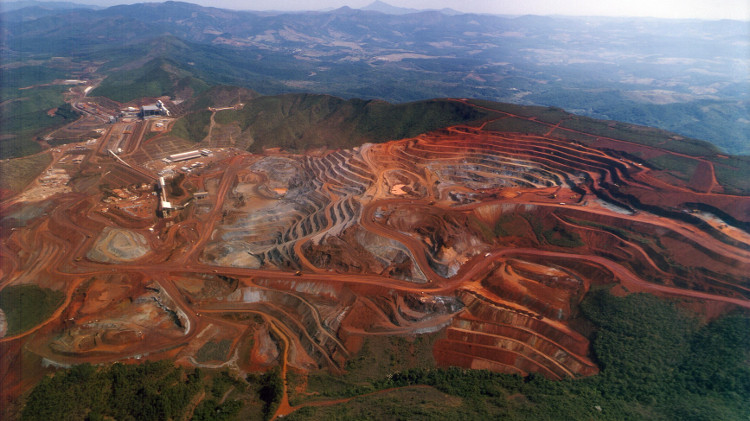(Left to right) Muskowekwan Chief Reginald Bellerose and Encanto CEO and president Stavros Daskos pose with Bobby Cameron, Chief of the Federation of Sovereign Indigenous Nations. Daskos says Bellerose has been “integral” to the success the company is having developing its potash project on the Muskowekwan’s territory. Courtesy of Encanto Potash Corp.
The Muskowekwan First Nation became the fourth indigenous group to successfully implement federal legislation that allows for on-reserve resource development in late March, paving the way for the Nation to build Canada’s first on-reserve mine.
The First Nation plans to develop a $3.5-billion potash project in southwestern Saskatchewan, in partnership with Vancouver-based junior miner Encanto Potash Corp.
The First Nations Commercial Industrial Development Act (FNCIDA) fills in a regulatory gap that had inhibited major investment, including mining projects, on First Nations land. The gap stems from the fact that First Nations fall under the jurisdiction of the federal government, which lacks regulatory systems to govern major resource and development projects. FNCIDA effectively transposes provincial regulations onto specified reserve land.
The legislation, which was pushed for by a handful of First Nations with resource development projects in the works, was introduced in 2005. First Nations who are interested in implementing FNCIDA are required to engage in an “exploratory period” – during which they consult with Indigenous and Northern Affairs Canada (INAC), the project proponent, and the provincial government – to determine if the legislation would fit their needs and if the province is willing to administer and regulate the project.
The First Nation must then pass a band council resolution requesting the legislation, beginning a process in which regulations are developed and negotiated between all three parties, which are responsible for their own legal fees.
The Muskowekwan began the FNCIDA process in 2013. “In order to have protection for people and land, these regulations need to be in place,” explained Alison Auramenko, director of economic development for the Muskowekwan. Lawyers for the Nation, she explained, went through the laws one by one, and in the end “mirrored” the provincial legislation. “We wanted a level playing field,” she said. “We didn’t want to be left behind.”
From an investor perspective, the regulation lends credibility to the project. “It means we have total security on our investment,” explained Encanto Potash Corp CEO Stavros Daskos. It ensures that the Muskowekwan “cannot decide to fence off the property and prevent us from getting in. This project is going to survive all of us. And you need a legal framework that is going to protect people’s investment."
In April, Encanto announced it had closed a $70-million deal with the investment bank Taylor-DeJongh to finance Encanto’s development phase activities. The money will be used to sustain the company as it goes forward with engineering plans, raising capital and assembling a management team. When asked if he thought there is a connection between concluding FNCIDA and the cash injection, Daskos said “of course it helped,” but added that “it’s not the only factor.”
Current relations between the miner and the Muskowekwan are good and, according to Daskos, Chief Reginald Bellerose has been an “integral” part of the project’s success. In 2010, Bellerose accompanied Daskos on a trip to India to meet with officials from state-run investment firms. That trip resulted in two new 20-year agreements to sell a total of seven million tonnes of potash annually.
The project is expected to employ around 1,800 people during its construction phase and have a 50-year mine life. Encanto has not yet set indigenous employment quotas. That, according to Auramenko, may be negotiated later. “It’s understood that one of the main pillars of the project is to get First Nations employed,” she said.
According to Neil Burnett, a policy director for INAC who is responsible for FNCIDA, the Nation’s successful adoption of the legislation is a “good example of how provincial and federal government and First Nations can all work together to advance First Nations economic opportunities.” The proposed project, he said, “clearly demonstrates that First Nations are a viable business partner for large-scale commercial and industrial development.”
Two of the three other First Nations to successfully implement FNCIDA are doing so to develop resource projects, explained Burnett. Alberta’s Fort McKay First Nation hopes to develop an oil sands project once oil prices pick up and Ontario’s Fort William First Nation used it to develop an on-reserve sawmill.
BC’s Squamish First Nation used the legislation to develop a condominium project. In British Columbia and Yukon Territory, many First Nations lack treaties and have battled to profit from resource development projects that they say lie in their traditional territory. Over the past 20 years, revenue sharing agreements have become increasingly common between miners and First Nations, but large scale, indigenous-run mining projects have remained elusive.
The Muskowekwan made a $3-million placement in Encanto and have a minority share in the company. So while they may not be in the driver’s seat, they still stand to reap financial benefits. The First Nation will have the ability to level royalties and are developing a framework with the First Nation Tax Commission and federal government to collect property taxes. INAC, however, retains significant power over the First Nation and will collect the royalties and lease fees on behalf of the Muskowekwan for the time being.
The money collected, said Auramenko, will be used to fund capital development projects and educational initiatives surrounding language and cultural revitalization. The potential benefits, she said, are huge. “If [Muskowekwan First Nation] can get their own source revenues, then they can set their own priorities.”




